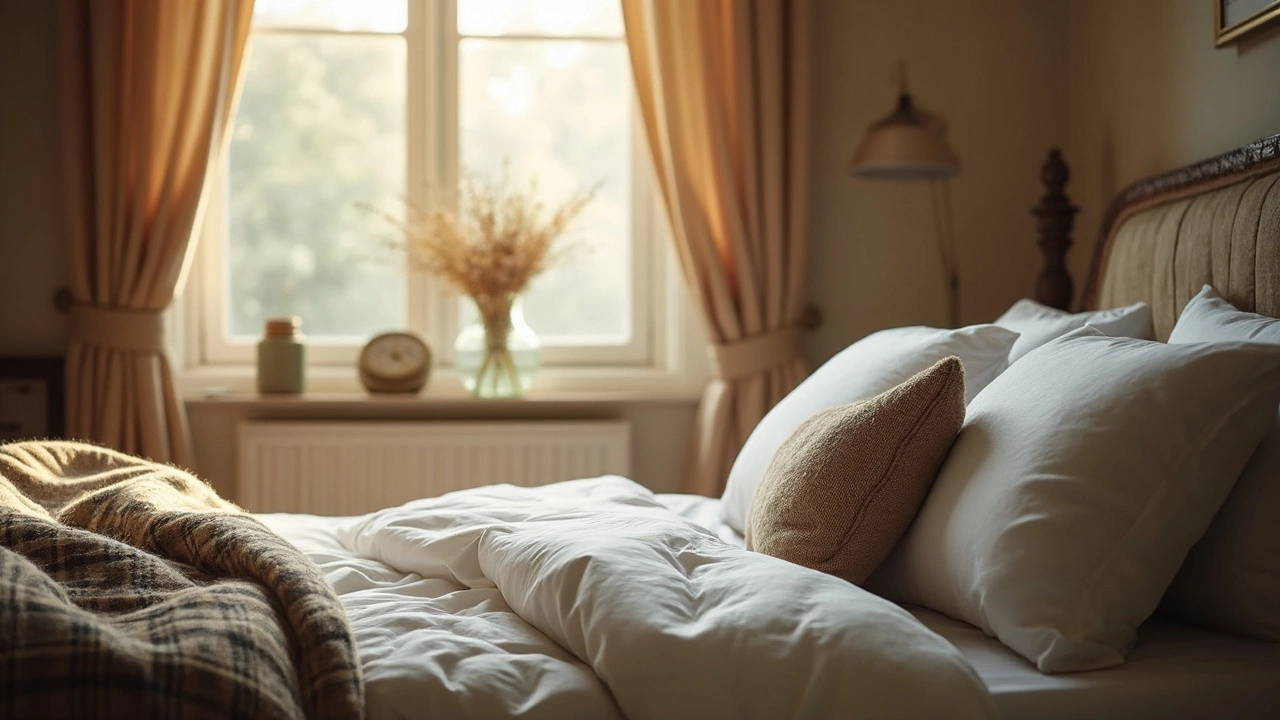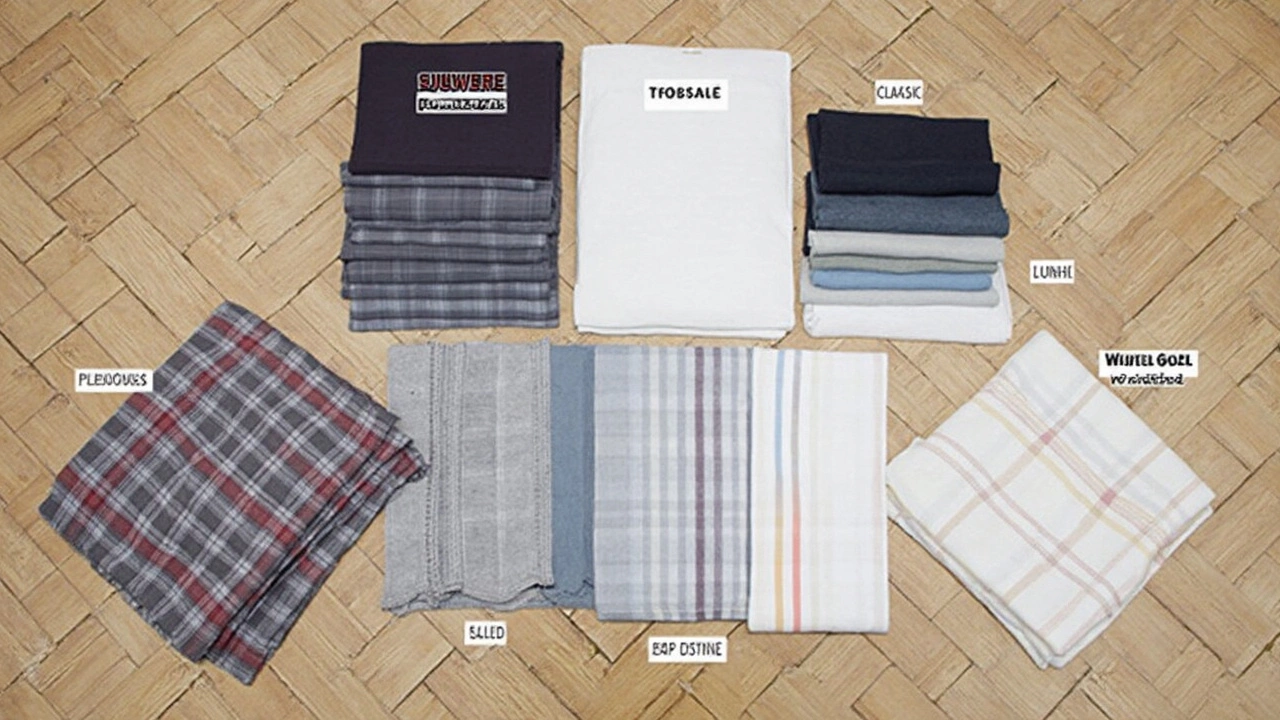Bedding Basics: What Does Bedding Really Mean?
 May, 17 2025
May, 17 2025
Ever wonder what people really mean when they talk about bedding? Most folks think of sheets, but bedding actually covers much more. We're talking about anything that goes on your mattress to make sleeping more comfortable—sheets, pillowcases, blankets, quilts, comforters, and even mattress protectors. It's basically the squad that stands between you and your mattress.
Getting the right bedding isn’t just about looks. Different fabrics can make a big difference in how cool or cozy you feel at night. For example, cotton sheets breathe well and feel soft, while flannel holds onto warmth for chilly nights. If you sweat a lot, microfiber or bamboo might keep things drier.
- What Counts as Bedding?
- Why Bedding Matters for Sleep
- Choosing the Right Bedding
- Caring for Your Bedding
What Counts as Bedding?
So, what actually fits under the bedding umbrella? It's more than just the sheet you lay on. When people talk about bedding, they’re referring to a whole set of things that go on your bed to make sleeping clean, comfortable, and even stylish.
Here’s a breakdown of what bedding usually includes:
- Sheets: This covers both the fitted sheet that hugs your mattress and the flat sheet that goes on top. Fitted sheets keep things in place, while flat sheets add that extra layer between you and your blankets.
- Pillowcases: These don’t just keep your pillow clean—they also keep oil and sweat off your face.
- Blankets and Comforters: Blankets are thinner and can be stacked for more warmth. Comforters are thicker, usually stuffed with down or synthetic materials for serious coziness.
- Quilts: Lighter than most comforters, quilts are great for layering or adding a pop of color.
- Mattress Protectors or Covers: These shield your mattress from spills, dust mites, and allergens. Some add extra padding for comfort.
- Bedsheets for Layering: In some places, people use multiple sheets for extra comfort or temperature control.
Some even count decorative items like shams, bed skirts, and throws as part of bedding, though these aren’t essential. It really depends on how fancy—or simple—you want your bed to be. The basics, though, will always be your sheets, pillowcases, blanket or comforter, and a mattress protector if you want your mattress to last longer.
Why Bedding Matters for Sleep
Think a sheet is just a sheet? Not really. The right bedding can mean the difference between tossing all night and getting deep, solid rest. Research from the National Sleep Foundation found that 73% of people say fresh sheets help them get better sleep. Your bedding's texture, temperature, and cleanliness all play a part in how well you actually snooze.
Here’s what your bedding impacts most:
- Bedding directly affects temperature control. Breathable materials like cotton or linen help you stay cool if you run hot at night. Thicker fabrics like flannel or fleece trap heat for those always-cold sleepers.
- Moisture-wicking bedding can help with night sweats, keeping you drier and less likely to wake up sticky.
- Softness isn’t just about feeling fancy—it can cut down on skin irritation and help you relax. Rough or scratchy bedding can make falling asleep way harder.
- Clean bedding lowers your risk of dust mites and allergies. Dirty sheets can hang onto sweat, dirt, and even acne-causing bacteria.
Check out this snapshot of how bedding decisions impact common sleep issues:
| Sleep Issue | Bedding Solution |
|---|---|
| Night Sweats | Bamboo or microfiber sheets |
| Feeling Cold | Flannel sheets and heavy blankets |
| Allergies | Hypoallergenic covers and frequent washing |
| Itchy Skin | Soft, high-thread count cotton |
So next time you’re yawning through a lousy night’s sleep, check your sheets and blankets. Upgrading your bedding is one of the easiest fixes out there.

Choosing the Right Bedding
When it comes to picking out bedding, you want comfort, easy care, and stuff that actually improves your sleep. The first thing to look at is the material. Cotton is popular for a reason—it’s breathable, soft, and doesn’t feel sticky in summer. If you like things real cozy, go for flannel in winter. Bamboo sheets stay cool, help with sweat, and are more eco-friendly. Microfiber is light and dries fast, but some people think it traps heat.
Thread count gets thrown around a lot, but here’s the real deal: Higher doesn’t always mean better. Anything between 200 and 400 is the sweet spot for cotton. Go too high, and you might end up with stiff or heavy sheets that don’t breathe well.
Allergies? Hypoallergenic bedding like tightly-woven cotton or microfiber can help keep out dust mites and other stuff that sets you off. You can also grab a mattress protector for extra peace of mind.
Here’s a quick rundown on some popular bedding materials and their perks:
| Material | Main Benefit | Best For |
|---|---|---|
| Cotton | Breathable, soft | Most people, year-round |
| Bamboo | Wicks moisture, stays cool | Hot sleepers |
| Flannel | Warm, cozy | Cold climates, winter |
| Microfiber | Affordable, dries quickly | Kids' rooms, budget setups |
For sizes, always double-check what fits your bed. Fitted sheets can shrink after washing, so if you're between sizes, size up. Duvet covers or comforters should have a little overhang for looks and to keep drafts out. Don’t forget pillows—memory foam works for neck support, while down feels softer. Wash pillowcases weekly to avoid breakouts and dust buildup.
- Pick the right material for how you sleep
- Keep an eye on thread count, not just the price tag
- Match your bedding size to your mattress and check for shrinkage after washes
- Bedding works best when you layer it—try mixing textures for comfort and style
A little attention goes a long way—choosing the right bedding can help you sleep deeper, wake up feeling better, and actually enjoy sliding under the covers at night.
Caring for Your Bedding
How you care for your bedding can make or break your comfort and even help you save money over time. Clean bedding isn’t just about keeping things looking nice—getting rid of sweat, dust mites, and allergens means better sleep and fewer sneezes. On average, most people should wash their sheets and pillowcases once a week. Comforters, quilts, and blankets can usually go two or three weeks between washes, unless there’s an obvious spill or mess.
- Always read the care label. Some materials like cotton and microfiber are washer-friendly, while silk or wool might need delicate cycles or even dry cleaning.
- Wash with cool or warm water. Hot water can wear out colors and fabrics faster, unless you’re trying to kill dust mites—then hot is best.
- Don’t go overboard on detergent; too much can leave residue and make your bedding feel stiff.
- Dry on low heat or air-dry to stop sheets and blankets from shrinking or getting rough.
- Rotate your bedding. Keep a couple of sets on hand so you’re not always washing the same stuff, and your bedding lasts longer.
| Bedding Item | Recommended Wash Frequency |
|---|---|
| Sheets/Pillowcases | Every 1 week |
| Blankets | Every 2-4 weeks |
| Comforters/Duvets | Every 1-2 months (with cover) or as needed |
| Pillows | Every 3-4 months |
Here’s a tip for keeping your bedding extra fresh: use a mattress cover and wash it monthly. It acts as a barrier and makes everything else easier to keep clean. If someone in your home has allergies, consider hypoallergenic options and wash more often.
Storing bedding right matters too. A cool, dry closet is ideal. Use breathable storage bins or bags, not plastic, to stop musty smells and let fabrics air out. If you’re storing for a season, toss in a cedar block or lavender sachet to keep things smelling clean, not like Grandma’s attic.